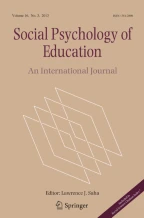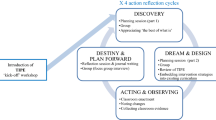Teachers’ experiences and recommendations to support refugee students exposed to trauma

Children from refugee backgrounds often experience multiple traumatic events and schools are uniquely placed to support these students. This study examined the experiences of teachers in supporting students from refugee backgrounds who have experienced trauma. Six teachers participated in interviews which were analysed using thematic analysis. Teachers reported challenges related to limited sharing of relevant background information, uncertainty about presenting classroom lessons sensitively, when to refer students for specialised intervention, and how best to support refugee students when external factors create continued challenges. The effectiveness of existing practices and recommendations for tailoring trauma-informed practices for this student population are discussed. The results are also discussed in the context of social constructivism and how teachers use their interactions with students and colleagues to inform how they respond to refugee students exposed to trauma.
This is a preview of subscription content, log in via an institution to check access.
Access this article
Subscribe and save
Springer+ Basic
€32.70 /Month
- Get 10 units per month
- Download Article/Chapter or eBook
- 1 Unit = 1 Article or 1 Chapter
- Cancel anytime
Buy Now
Price includes VAT (France)
Instant access to the full article PDF.
Rent this article via DeepDyve
Similar content being viewed by others

Multidisciplinary approaches to establishing trauma informed practice for pre-service teachers
Article Open access 04 March 2024

Article 23 November 2021

Shifting Teacher Practice in Trauma-Affected Classrooms: Practice Pedagogy Strategies Within a Trauma-Informed Positive Education Model
Article 02 January 2019
Explore related subjects
Data Availability
Not available for participant confidentiality.
References
- Alisic, E. (2012). Teachers’ perspectives on providing support to children after trauma: A qualitative study. School Psychology Quarterly,27(1), 51–59. https://doi.org/10.1037/a0028590ArticleGoogle Scholar
- Centre for Multicultural Youth (CMY). (2018). Information Sheet: Youth arrivals to Victoria July 2016-June 2017. Author.
- Baker, J. A. (2006). Contributions of teacher–child relationships to positive school adjustment during elementary school. Journal of School Psychology,44(3), 211–229. https://doi.org/10.1016/j.jsp.2006.02.002ArticleGoogle Scholar
- Berger, E. (2019). Multi-tiered approaches to trauma-informed care in schools: A systematic review. School Mental Health,11(4), 650–664. https://doi.org/10.1007/s12310-019-09326-0ArticleGoogle Scholar
- Berger, E., & Samuel, S. (2020). A qualitative analysis of the experiences, training, and support needs of school mental health workers regarding student trauma. Australian Psychologist,55(5), 498–507. https://doi.org/10.1111/ap.12452ArticleGoogle Scholar
- Berger, E., Bearsley, A., & Lever, M. (2020). Qualitative evaluation of teacher trauma knowledge and response in schools. Journal of Aggression, Maltreatment & Trauma. https://doi.org/10.1080/10926771.2020.1806976. ArticleGoogle Scholar
- Berger, E., Carroll, M., Maybery, D., & Harrison, D. (2018). Disaster impacts on students and staff from a specialist, trauma-informed Australian school. Journal of Child and Adolescent Trauma,11(4), 521–530. https://doi.org/10.1007/s40653-018-0228-6ArticleGoogle Scholar
- Blaustein, M. E., & Kinniburgh, K. M. (2018). Treating traumatic stress in children and adolescents (2nd ed.). The Guilford Press.
- Braun, V., & Clarke, V. (2006). Using thematic analysis in psychology. Qualitative Research in Psychology,3(2), 77–101. https://doi.org/10.1191/1478088706qp063oaArticleGoogle Scholar
- Cummings, K., Addante, S., Swindell, J., & Meadan, H. (2017). Creating supportive environments for children who have had exposure to traumatic events. Journal of Child and Family Studies,26(10), 2728–2741. https://doi.org/10.1007/s10826-017-0774-9ArticleGoogle Scholar
- Department of Immigration and Border Protection (DIBP). (2018a). Australia’s response to the Syrian and Iraqi humanitarian crisis.https://www.homeaffairs.gov.au/trav/refu/response-syrian-humanitarian-crisis
- Department of Immigration and Border Protection (DIBP). (2018b). Fact Sheet: Australia’s Refugee and Humanitarian Program.https://www.homeaffairs.gov.au/about/corporate/information/fact-sheets/60refugee
- Department of Social Services. (2017). Building a New Life in Australia (BNLA): The Longitudinal Study of Humanitarian Migrants ─ Findings from the first three waves. Canberra: Department of Social Services.https://www.dss.gov.au/sites/default/files/documents/03_2018/d17_1138305_bnla_report_final_word_accessible_version.pdf
- Derluyn, I., Mels, C., & Broekaert, E. (2009). Mental health problems in separated refugee adolescents. Journal of Adolescent Health,44(3), 291–297. https://doi.org/10.1016/j.jadohealth.2008.07.016ArticleGoogle Scholar
- Dorado, J. S., Martinez, M., McArthur, L. E., & Leibovitz, T. (2016). Healthy environments in response to trauma in schools (HEARTS): A whole-school, multi-level, prevention and intervention program for creating trauma-informed, safe and supportive schools. School Mental Health,8(1), 163–176. https://doi.org/10.1007/s12310-016-9177-0ArticleGoogle Scholar
- Dryden-Peterson, S. (2016). Refugee education in countries of first asylum: Breaking open the black box of pre-resettlement experiences. Theory and Research in Education,14(2), 131–148. https://doi.org/10.1177/1477878515622703ArticleGoogle Scholar
- Due, C., & Riggs, D. (2016). Care for children with migrant or refugee backgrounds in the school context. Children Australia,41(3), 190–200. https://doi.org/10.1017/cha.2016.24ArticleGoogle Scholar
- Foundation House. (2019). Schools and Families in Partnership: A Desktop Guide to Engaging Families from Refugee Backgrounds in their Children’s Learning. https://www.foundationhouse.org.au/wp-content/uploads/2019/12/SCHOOLS_FAMILIES_PARTNERSHIP_DESKTOP-GUIDE_WEB_cr.pdf
- Hurley, J. J., Saini, S., Warren, R. A., & Carberry, A. J. (2013). Use of the Pyramid Model for supporting preschool refugees. Early Child Development and Care,183(1), 75–91. https://doi.org/10.1080/03004430.2012.655242ArticleGoogle Scholar
- Im, H., Rodriguez, C., & Grumbine, J. M. (2020). A multitier model of refugee mental health and psychosocial support in resettlement: Toward trauma-informed and culture-informed systems of care. Psychological Services. Advance online publication. https://doi.org/10.1037/ser0000412
- März, V., & Kelchtermans, G. (2020). The networking teacher in action: A qualitative analysis of early career teachers’ induction process. Teaching and Teacher Education. https://doi.org/10.1016/j.tate.2019.102933ArticleGoogle Scholar
- Miller, J., & Berger, E. (2020). A review of school trauma-informed practice for Aboriginal and Torres Strait Islander children and youth. The Educational and Developmental Psychologist,37(1), 39–46. https://doi.org/10.1017/edp.2020.2ArticleGoogle Scholar
- Miller, K. K., Brown, C. R., Shramko, M., & Svetaz, M. V. (2019). Applying trauma-informed practices to the care of refugee and immigrant youth: 10 clinical pearls. Children,6, 94. https://doi.org/10.3390/children6080094ArticleGoogle Scholar
- Morgan, A., Pendergast, D., Brown, R., & Heck, D. (2015). Relational ways of being an educator: trauma-informed practice supporting disenfranchised young people. International Journal of Inclusive Education,19(10), 1037–1051. https://doi.org/10.1080/13603116.2015.1035344ArticleGoogle Scholar
- Multicultural Youth Advocacy Network (MYAN). (2017). Information Sheet: Humanitarian and Migrant Youth Arrivals to Australia July 2015-June 2016. Centre for Multicultural Youth.
- Nagasa, K.(2014). Perspectives of Elementary Teachers on Refugee Parent-Teacher Relations and the Education of Their Children. Journal of Educational Research and Innovation, 3(1). http://digscholarship.unco.edu/jeri/vol3/iss1/1
- Overstreet, S., & Chafouleas, S. M. (2016). Trauma-Informed Schools: Introduction to the Special Issue. School Mental Health. 8(1), 1 https://doi.org/10.1007/s12310-016-9184-1.
- Reed, R., Fazel, M., Jones, L., Panter-Brick, C., & Stein, A. (2012). Mental health of displaced and refugee children resettled in low-income and middle-income countries: Risk and protective factors. The Lancet,379(9812), 250–265. ArticleGoogle Scholar
- Rutter, J. (2006). Refugee Children in the UK. McGraw-Hill Education.
- Savin-Baden, M., & Howell Major, C. (2013). Qualitative Research: The essential Guide to theory and practice. Routledge.
- Substance Abuse and Mental Health Services Administration (SAMHSA). (2014). SAMHSA’s concept of trauma and guidance for a trauma-informed approach. https://store.samhsa.gov/system/files/sma14-4884.pdf
- Sullivan, A. L., & Simonson, G. R. (2016). A systematic review of school-based social- emotional interventions for refugee and war-traumatized youth. Review of Educational Research,86(2), 503–530. https://doi.org/10.3102/0034654315609419ArticleGoogle Scholar
- Szente, J., Hoot, J., & Taylor, D. (2006). Responding to the special needs of refugee children: Practical ideas for teachers. Early Childhood Education Journal,34(1), 15–20. https://doi.org/10.1007/s10643-006-0082-2ArticleGoogle Scholar
- Taylor, S., & Sidhu, R. K. (2012). Supporting refugee students in schools: What constitutes inclusive education? International Journal of Inclusive Education,16(1), 39–56. https://doi.org/10.1080/13603110903560085ArticleGoogle Scholar
- United Nations High Commission for Refugees (UNHCR). (2016). UNHCR viewpoint: ‘Refugee’ or ‘migrant’ – Which is right? https://www.unhcr.org/news/latest/2016/7/55df0e556/unhcr-viewpoint-refugee-migrant-right.html.
- United Nations High Commission for Refugees (UNHCR). (2017). Global Report 2017. https://www.unhcr.org/enau/publications/fundraising/5b4c89bf17/unhcr-global-report-2017.html.
- United Nations High Commission for Refugees (UNHCR). (2018). Global Trends: Forced Displacement in 2017. Author.
- Victorian State Government. (2021a). Supporting students from refugee backgrounds.https://www.education.vic.gov.au/school/teachers/support/diversity/eal/Pages/ealsupportrefugee.aspx
- Victorian State Government. (2021b). Supporting students from refugee backgrounds.https://www2.education.vic.gov.au/pal/eal-provision/policy?Redirect=1
Funding
This research did not receive any specific grant from funding agencies in the public, commercial, or not-for-profit sectors.




